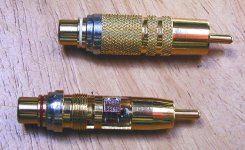My office system is way too loud. It is a cd player (no volume control) to BOSOZ preamp to amp to speakers. I can only get 1 click on the preamp volume controls and its still too loud. I need background music at low volumes and some vol control wiggle room.
What I'd like to do is install some attenuation into my CD->PRE or PRE->AMP interconnects without messing up the treble response. Seems a series resistor in the + lead and a resistor to ground should do it (talking about the RCA connection here). But what should the values be and where should I install this?
What I'd like to do is install some attenuation into my CD->PRE or PRE->AMP interconnects without messing up the treble response. Seems a series resistor in the + lead and a resistor to ground should do it (talking about the RCA connection here). But what should the values be and where should I install this?
You can calculate the values here: 50-Step Shunt Attenuator Resistor Calculator - Neville Roberts
Normally, you should only need appropriate value series resistor as the shunt resistor is usually already inside the equipment.
Here's the adapter I made for a customer (using Cardas parts) who needed additional attenuation with my amps: 22k series resistor (nude Vishay) will add 6dB of attenuation with 22k shunt that was in the amp.
Normally, you should only need appropriate value series resistor as the shunt resistor is usually already inside the equipment.
Here's the adapter I made for a customer (using Cardas parts) who needed additional attenuation with my amps: 22k series resistor (nude Vishay) will add 6dB of attenuation with 22k shunt that was in the amp.
Attachments
if you want -20dB then the resistors are in a 9:1 ratio. -40dB requires a 99:1 ratio.
For this to hold true the input impedance (Rin) of the amp must be much greater than the grounding resistor (Rg).
Take a 9k and 1k pair. At first sight this gives the 9:1 ratio and should give -20dB.
attenuation = 20 * log [1 / (9+1)] gives -20dB.
Now take the input impedance of the amplifier into account.
Rin=100k.
attenuation = 20 * log[1//100 / (9+1//100)] gives -20.1dB. not too much of an error.
Rin=10k.
attenuation = 20 * log[1//10 / (9+1//10)] gives -20.7dB. the error is 7times bigger.
The closer Rin to Rg the worse the error gets.
The pre-amp/source sees the attenuator and the 22k amp as a 10k001 load.
Using 9k1 and 1k the attenuator has an output impedance of 901r and creates -20.35dB when Rin=22k
You can check whether that 901r source impedance causes an HF roll off problem.
The pre-amp sees the attenuator and 22k amp as a 10k001 resistive load in parallel with the the cable capacitance.
For this to hold true the input impedance (Rin) of the amp must be much greater than the grounding resistor (Rg).
Take a 9k and 1k pair. At first sight this gives the 9:1 ratio and should give -20dB.
attenuation = 20 * log [1 / (9+1)] gives -20dB.
Now take the input impedance of the amplifier into account.
Rin=100k.
attenuation = 20 * log[1//100 / (9+1//100)] gives -20.1dB. not too much of an error.
Rin=10k.
attenuation = 20 * log[1//10 / (9+1//10)] gives -20.7dB. the error is 7times bigger.
The closer Rin to Rg the worse the error gets.
The pre-amp/source sees the attenuator and the 22k amp as a 10k001 load.
Using 9k1 and 1k the attenuator has an output impedance of 901r and creates -20.35dB when Rin=22k
You can check whether that 901r source impedance causes an HF roll off problem.
The pre-amp sees the attenuator and 22k amp as a 10k001 resistive load in parallel with the the cable capacitance.
Last edited:
- Status
- Not open for further replies.
